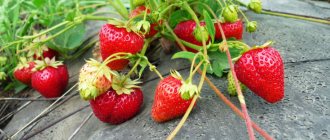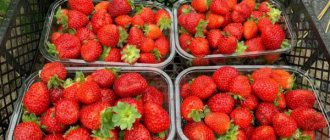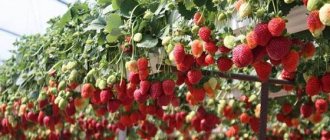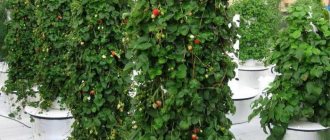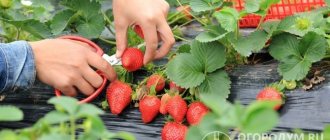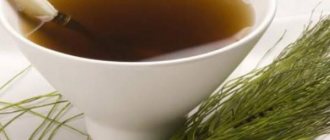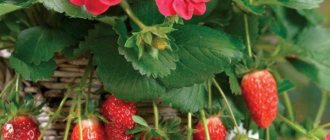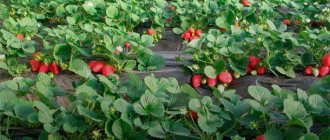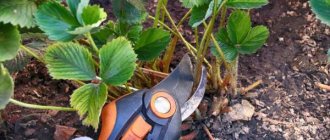Home / Garden / Berries
Back
Published: 07/05/2020
3
5/5 — (4 votes)
In catalogs of berry crops, ampelous strawberries immediately attract attention. In the photo there are cascades of green leaves, garlands of red-ruby berries, and all this splendor seems like a real fairy tale. Now that a variety of varieties of ampelous strawberries have been bred, everyone can grow the crop with proper care.
- 1 What is ampel strawberry
- 2 Description and features of ampelous strawberries
- 3 Agricultural technology 3.1 Planting
- 3.2 Care
- 3.3 Reproduction
How to overwinter strawberries climbing on the balcony
Climbing (hanging) strawberries have become a real hit among balcony plants .
This is hardly surprising - throughout the entire season, from spring to autumn, it decorates the balconies alternately with flowers and delicious strawberries, so beloved by most of us. With the arrival of autumn and the first cold weather, the question arises, how will the climbing strawberries on the balcony survive the winter? We present 3 proven methods for overwintering hanging strawberries. Climbing strawberries, also called trailing or drooping strawberries , produce long, fruiting shoots. These shoots can hang down when we plant the strawberries in a box suspended on a balcony balustrade or in a hanging flower pot, or they can climb on supports that we prepare for them. When strawberries bloom and bear fruit, they look great. But, most importantly, these are varieties of strawberries with repeated fruiting , thanks to which this picturesque show lasts the entire season, and the last berries can be picked in the fall, before the first frost. This explains why growing climbing strawberries on balconies and terraces has become so popular. ⇒Strawberries on the balcony
These wonderful signs of climbing strawberries - drooping, repeating fruiting - are, however, also due to the fact that these strawberries are less frost-resistant than ordinary ground strawberries. This happens because varieties of climbing strawberries usually come from countries with warmer climates. Therefore, these plants require special conditions in order to survive the winter. It is necessary to protect climbing strawberries well from frost, especially the roots.
Description
All varieties of ampelous strawberries have a set of common external characteristics. The bushes are compact, 20-30 cm in diameter. The mustache branches can reach 50-100 cm. The flowers of most varieties are white, but there are especially decorative varieties with pink petals. The berries are bright red, the shape depends on the variety. Typically, all varieties of hanging crops have medium-sized berries, weighing up to 30 grams, and ripen quite quickly. The taste is pleasant, with a slight sourness. There are varieties of short and neutral days.
Attention! The rich color of the berries depends on the presence of potassium fertilizers and sufficient air humidity.
Method 2 - Overwinter indoors
Climbing strawberries - growing hanging in flower pots, can be moved for the winter to a room protected from frost, but always cool enough, where the temperature in winter will be close to 0⁰C. For this you can use basements or attics; it is important that the room is bright, with access to light and not damp.
After bringing the strawberries indoors, carefully water them and then throughout the winter period make sure that the soil in the flower pot is slightly moist (but not wet). Generally, a light watering once every two weeks is sufficient.
In the spring, we harden the plants, first we start by ventilating the room in which the strawberries are stored from the balcony, and then putting the flower pots with strawberries outside for the whole day and bringing them in only at night. Strawberries can return to their permanent place on the balcony and terrace when the danger of night frosts has passed, that is, from the second half of May.
Popular varieties
Getting to know the most popular varieties will help you choose the best ones in terms of yield and decorative qualities. Remontant ampel strawberries, the care and cultivation of which in the garden brings great pleasure and enjoyment, may differ in the size of the fruit, the shade of the petals, the number of rosettes and other characteristics.
- Queen Elizabeth II is a rather capricious heat-loving variety, acclimatized to our conditions, but requiring replanting at least once every two years. It bears fruit not continuously, with a short rest between two or three periods of flowering. The berries are dense, large, weighing from 40 g, bright red, cone-shaped.
With careful care, the weight of the berries can reach 120 g
Note! When purchasing seeds or seedlings, this variety is often confused with the regular Queen Elizabeth I strawberry.
- Tuscany is a plant with not very large oblong berries and pink flowers (photo above), which, with its modest size, allows you to get up to 1 kg of fruit from each bush.
- Temptation F1 - this variety is distinguished by a large amount of green mass, large flowers and berries with a light nutmeg aroma. It tolerates frost well, but is not resistant to long-term heat and drought. Productivity – up to 1.5 kg per bush per season. The first berries ripen at the end of May.
More on the topic: Chamora Turusi strawberries
The F1 icon indicates the hybrid origin of the variety and the undesirability of its propagation by seeds
- Ostara is one of the most unpretentious varieties. The first June berries are quite large, but not numerous. Towards the end of summer they become smaller, but appear in large numbers, so the bulk of the harvest occurs in August-September.
Strawberry Ostara
- Geneva is a product of American breeders, the main advantage of which is the ability to actively bear fruit for up to 5-6 years in one place without transplanting. But this variety does not tolerate thickening. Its bushes are quite spreading, and when planted closely, the plant becomes sick with gray rot. Therefore, they are planted at a sufficient distance from each other, and the few growing mustaches are evenly distributed throughout the garden bed.
- Pink miracle is another variety with pink flowers. It is very resistant to diseases and frost-resistant, can winter without shelter. The berries are small, bright red, very aromatic.
Blooming Pink Miracle
- Pink flamingo is a large-fruited ampelous strawberry; care and cultivation at home or in an apartment gives results all year round. The berries are truncated, rough, with convex seeds. With regular feeding they can grow to the size of a chicken egg.
- Elsanta is a classic high-yielding variety that produces up to 2 kg of fruit from one bush. Not too cold-resistant; in regions with little snow, it requires shelter for the winter.
The tips of the first Elsanta berries are light
Method 3 - overwinter on the balcony
If we do not have a personal plot where plants can be buried in the ground, and storage space, hanging strawberries can successfully overwinter on the balcony, then we install flower pots with plants in fairly large cardboard boxes. We put foam plastic on the bottom of the box as an insulating layer. We fill the sides of the flower pot with small pieces of foam plastic, sawdust or torn newspapers, so that the entire box is filled with insulating material. We also close the top; some use additional protection measures by wrapping the cardboard box with agrofibre. It is important that breathable materials that allow air and moisture to pass through are used for shelter. ⇒Agrofibre – application on a personal plot
During periods of thaw, we open the boxes and lightly water the plants. The soil in the pots should always be slightly moist; the strawberry roots should not dry out. Thus, balcony strawberries can overwinter until spring. When it gets warmer, we gradually tear off the boxes, at first, exposing the plants only for a day - for hardening.
Should I prune strawberries before wintering?
The main principle is to prune the shoots on which the strawberries have already bear fruit, since in subsequent years only new shoots will bear fruit abundantly. This can be done in the fall (which will make it much easier to carry indoors or install for storage in a cardboard box) or in the spring, when the plants will need to be inspected again and leaves and frozen shoots removed.
We do not store strawberries for the winter longer than 2-3 years, since only young plants bloom and bear fruit profusely. Old copies should be replaced with new ones.
“House garden and vegetable garden” www.zagorodacha.ru
If you found the article interesting, please vote for it using your social network, and if you have anything to add,
be sure to leave your comment on the site>>>
source
Bush propagation
Ampelous strawberries are propagated by rooting tendrils from the mother plant.
Further reproduction occurs through stepchildren - several new branches can grow from one mustache.
If you plant such a crop on a closed, warm balcony, and grow tendrils on a pre-prepared frame, you will get a beautiful weaving that will serve as both a decoration and a garden bed. However, the strawberry itself cannot twist itself - you just need to tie up the resulting stems where you want.
How to keep hanging strawberries in a hanging garden in winter?
Ampel strawberry is more of a conventional name that we use when looking at the hanging bunches of berries. This method of growing strawberries became so popular in the Baltic countries.
The fashion for the hanging method of growing strawberries has come to us, which is not surprising. Throughout the season, from spring to autumn, the plants are decorated with alternating flowers and delicious berries, which most of us have enjoyed since childhood.
However, with the advent of autumn and the first cold, the question arises of how to preserve the plants grown on the balcony hanging garden? Today we will present three proven ways to keep hanging strawberries in your home garden in winter!
Hanging strawberries , also called hanging strawberries, produce long fruiting shoots. These stems may droop if the strawberries are planted in pots, either on a balcony balustrade or in a hanging pot. Also, it looks good if you lift it on supports.
When these
strawberries bloom and bear fruit, they look great.
But, most importantly, these varieties of strawberries bear fruit continuously, so this colorful show lasts throughout the season, and the last harvest of berries can be harvested in the fall, before frost sets in. This explains why growing strawberries on balconies and terraces has become so popular.
However, these remarkable features of the ampelous appearance - hanging stems, continuous fruiting - are also due to the fact that these varieties of strawberries are less frost-resistant than ordinary garden ones.
This is because varieties of these varieties usually come from countries with warmer climates. Therefore, these plants require special conditions to survive in winter. We must protect them well from freezing, this is especially important to protect their root system.
Diseases and pests
Any variety of strawberry - garden or ampelous - is subject to attacks by the same pests, microbes, viruses, and fungi. Thanks to growing at altitude, ampel strawberries get sick less often. Table 2 shows common diseases and pests of hanging varieties, and measures to combat them.
table 2
| Pests/diseases | Harm/symptoms | How to fight? |
| Powdery mildew | The edges of the leaves curl, the berries become covered with an ashy coating. | Cleaning up dried and damaged leaves. In the spring, they are sprayed with Bordeaux mixture 3, and after harvesting, the plantings are treated with a 1% solution. For prevention, plantings are sprayed in the spring with a solution of sulfaride (per 10 liters - 2 tablespoons). |
| Strawberry mite | The fruits of the affected bushes are deformed, the leaves are weakened. | In spring - preventive spraying with Nero, Aktelik, Fufanon. Plantings are also sprayed with one of these preparations after harvesting and before cold weather. If a tick infestation has already occurred, spraying is carried out every 3 weeks. Mandatory - before flowering and before the formation of ovaries. |
| Nematodes | Transparent microscopic worms up to 1 m long. They suck juices from leaves and stems. The foliage wrinkles, the stems shorten, the berries harden. | The affected bushes are watered with a bleach solution, then they are pulled out and burned. The remaining bushes are sprayed with a solution of phosphamide or mercaptophos - 2-3 times with an interval of 4-5 days. |
| Strawberry weevil | Holes appear in the leaves and larvae appear in the buds. | The plantings are sprayed with Decis, Iskra, and Karbofos. |
| Gray rot | A fungal disease that develops at high humidity. Light brown fluffy spots appear. The disease can destroy 90% of the crop. | For prevention, plants are sprayed with Bordeaux mixture 3%. After harvesting the berries, use azotene (20 g per 10 liters of water). |
| Late blight | Withering and drying of leaves. Dying of roots. | After harvesting diseased bushes, disinfect the soil. Treatment with copper preparations - oxychloride or Bordeaux mixture. When signs of disease appear, spray with Ridomil, Horus or other fungicides. |
Wintering strawberries in the room
Ampelous strawberries , which grow in pots, can also be moved to rooms protected from frost in winter, but cold enough, where winter temperatures will be close to 0 ° C.
This could be a basement or attic, but it is important that the room is bright, has access to light and air, and is protected from getting wet. After moving the strawberries indoors, we carefully water them, and then throughout the winter we take care to keep the soil in the pots slightly moist (but not waterlogged). Watering once every two weeks is usually sufficient.
Starting in spring , the plants are taken out of the rooms in which balcony strawberries are stored into the street during the day and hidden at night. On an ongoing basis, strawberries are left on the balcony or terrace at a time when the risk of night frosts passes, that is, from the second half of May.
Rules of care
The main care is regular watering. Plants absorb the most moisture during flowering and when the berries are set. Watering is carried out like this. You constantly need to add water to the saucer under the pot. If strawberries grow in boxes or containers, water directly to the bud. But this must be done very carefully so that the plant itself does not get wet.
Note. Fungal diseases may appear on wet stems, flowers and berries (due to improper watering).
You can’t go anywhere without fertilizer. But watering alone is not enough.
Plants should also be fed regularly. As a top dressing, choose liquid fertilizers for vegetables and plants that bear fruit. The best option is considered to be natural fertilizer, for example, vermicompost. Watch carefully to ensure that no fungus or pests appear on the plants. If this happens, act with lightning speed! If gray mold has formed on the leaves, the affected parts of the plant should be removed and then treated with Zircon.
With proper care, the strawberries on your balcony will bear fruit for about three years. After this, the old bushes need to be updated, replacing them with new ones.
Wintering strawberries on the balcony
If you do not have a garden where plants can be transferred to the ground or storage rooms where plants can overwinter, then a balcony can also be successfully used for storing hanging strawberries. Containers with plants are placed in a suitable large cardboard box.
In its lower part, polystyrene is laid as an insulating layer. On the sides of the pots, crushed pieces of polystyrene, sawdust or torn newspapers are poured so that the entire box is filled with insulating material.
We also cover with protective material . Some gardeners use additional protection by wrapping the box with agrotextiles. It is important to use breathable materials that allow air and moisture to pass through.
During periods of thaw, we unwrap the boxes and lightly water the plants. The soil in the pots should be kept slightly moist to prevent the strawberry roots from drying out. Thus, you can keep strawberries on the balcony from winter until spring.
In the spring , when the boxes warm up, we gradually open them, initially exposing the plants only for a day to allow them to adapt.
Landing
Let's go through all the stages of rooting strawberries in a pot step by step.
Let's learn how to care for strawberries grown in pots.
Watering
The procedure is very important, since in this case moisture is supplied only artificially: pots of strawberries are unlikely to get exposed to rain.
Read also: How to cook pancakes with cream
Water the soil as the top layer dries. Under no circumstances should the soil be allowed to dry out completely, as this can lead not only to crop loss, but also to the death of strawberry bushes.
However, you should not be too zealous with watering. If the soil in the pot is regularly waterlogged, rotting of the strawberry roots will not take long to occur.
Experienced gardeners use the submersible method for watering strawberries, which is usually used when growing orchids. The pot is simply immersed in a large container of water, avoiding the edges of the pot from flooding. Through the drainage holes, water penetrates into the pot and immediately moisturizes the roots.
Important: after submersible watering, allow excess water to drain quietly from the holes.
Top dressing
This is also a very important stage of care. In a closed space, strawberries have nowhere to get the necessary minerals, so they will have to be fertilized regularly.
You can use mineral compounds and organic matter:
Among the mineral compositions, the Kemira Lux complex fertilizer is optimal. The feeding scheme is as follows:
Fertilizing is combined with watering; the application of dry fertilizers is undesirable.
Pruning strawberries before wintering
The main rule for getting a good harvest next year is to cut off fruit shoots on which strawberries no longer bear fruit, because in subsequent years they will produce abundant berries only on new shoots.
This pruning can be done in the fall. But this procedure can also be carried out in the spring, when the plants need to be further reviewed and old leaves or damaged shoots removed.
Growing bananas at home is fun. Find out more about this.
Worth knowing! Strawberries grown on the balcony bear fruit for 2-3 years. After this period, you should replace the strawberry plants with new ones and again enjoy a delicious harvest from your balcony.
And for those who like to know more, we suggest you watch the video about ampelous strawberries
Growing
The best way to plant hanging strawberries depends on many factors. For example, for what purpose is it grown? If you want to decorate your home or garden, it is better to use seeds and immediately grow them in vases, pots, pyramids, cassettes or flowerpots. To harvest, it is better to purchase seedlings from mother bushes.
The soil for propagating ampelous strawberries should be neutral acidity, well-drained, and light. A place is chosen without drafts, illuminated for 8 hours.
In pots from seeds
Growing ampelous strawberries from seeds is suitable for apartment conditions. The plant germinates under any conditions. The bushes are unpretentious and give a good harvest. The shoots don’t need to be rooted, just let them hang down. They can receive nutrients from the main bush. The shelf life of seeds is 5 years, but after 2 years they lose their germination quality. Therefore, it is recommended to choose packaging material that is no more than 7-10 months old.
Before growing ampelous strawberries from seeds, you should prepare the soil. For seedlings, take a ready-made mixture or prepare it yourself. The main thing is to enrich it with micronutrients, which are freely sold in the store. Germinate mono seeds or sow dry. Moisten with a sprayer and place glass on top.
The glass is removed 2-3 times every 7 days to ventilate the soil. After 3 leaves appear, the plant is picked. Planting ampelous strawberries and further care does not take much time. The main thing is to maintain soil moisture. Stronger bushes can be transplanted into flowerpots 2-3 months after planting the seeds.
Knowing how to care for ampelous strawberries, you can harvest throughout the year.
In a bed of ready-made seedlings
How to properly grow ampelous strawberries from seedlings? After acquiring the mother bushes, most of the greenery is removed. Prepared beds are fertilized with a mixture of sand, humus and turf. Spill with a light manganese solution. The soil is shaken off the bush, long shoots are cut off at the roots. The root itself is treated with “Heteroauxin” and deepened by 3 cm. The root shoots should not be allowed to remain on the surface of the earth. Strawberries are watered as the soil dries out only with warm water. The cold will slow down growth.
Knowing how to care for ampelous strawberries, you can harvest throughout the year. 80% humidity and 7-10°C are optimal development conditions. During fruiting, humidity should not be higher than 50-60%, temperature 20-25°C. The plant does not tolerate excess water, so it is better to water it in a tray. This will prevent the soil from becoming waterlogged.
